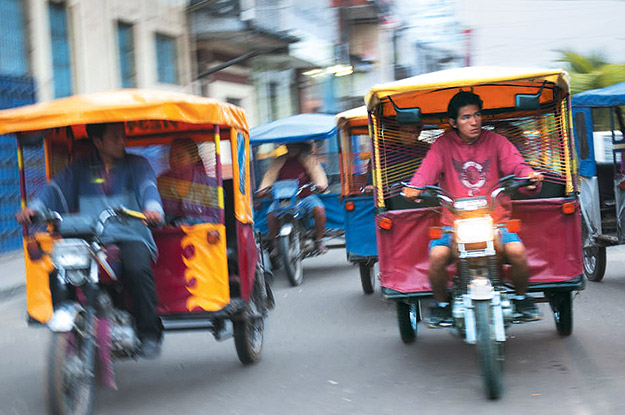A visitor to the Amazon rain forest might expect to hear the call of birds, the buzz of insects and the screech of monkeys — but probably not car horns and roaring motors. Yet those are the predominant sounds echoing through the streets of Iquitos, a metropolis deep in the Peruvian Amazon.
Iquitos has a reputation as perhaps the noisiest city in Latin America, and after just a few minutes on the street, it’s easy to hear why. The city’s traffic is not only congested, but also unusually loud. Urban Amazonians have long relied on motorcycles and mototaxis — three-wheeled motorized rickshaws — for transportation because roads were often impassable for larger vehicles. While cars and buses have arrived in many cities, mototaxis continue to be the main form of public transportation in Iquitos. Their numbers tripled between 2000 and 2009, from 5,700 to more than 17,000. But the problem is not so much the vehicles as their mufflers — or rather, the lack of them.
Eduardo Tagle, director of environmental quality at Peru’s Environment Ministry, says drivers think the mufflers reduce the motor’s potency, so they remove them. Ysaac Panduro, assistant director of environmental health in Iquitos, adds that mufflers and tailpipes corrode quickly in the Amazonian humidity, and drivers fail to replace them.
A tendency to associate noise with power may also be part of the equation for men who migrate from rural areas to the city and work as mototaxi drivers. Whatever the reasons, the sounds reverberating from the streets of this city disrupt work and education, and citizens have begun to take action.
Efrocina Gonzales, cofounder of a civic group called Everyone Against the Noise, is among them. Returning to work after recovering from an injury, she realized that the source of the stress she felt in the mornings and evenings was the traffic noise that assailed her during her daily commute.
“I think people aren’t aware of the harm noise does to them, and public officials aren’t very interested in the problem,” says Gonzales.
Gonzales’ suspicions are borne out in studies by the World Health Organization, which have linked excessive noise to hearing impairment, irritability and sleep disturbance. It is also associated with high blood pressure and heart disease.
Hopes for relief rest on a new plan by Peru’s Environment Ministry to improve noise monitoring and enforcement in Iquitos, and to create “special protection zones” with a maximum of 50 decibels around schools and hospitals, as well as lower speed limits. It also calls for converting some downtown streets into pedestrian walkways, promoting bicycling, and relocating some businesses to industrial zones.
The proposed anti-noise plan, set to be presented in September, is based on a recent government study commissioned by the Environment Ministry in coordination with the local government, which identified some of Iquitos’ most problematic noise sources, ranging from the municipal diesel powered electricity generating plant to for-profit barbecues where outdoor speakers blast music. The plan’s success will depend mainly on local enforcement — and the noisemakers themselves.
Others are taking matters into their own hands as well. At Rosa Agustina Donayre de Morey School, a public school where teachers are often drowned out by the din, a pilot project financed by the German government provided fans and air conditioners and replaced lattice cinderblock walls with windows in three classrooms.
The performance of students using those rooms will be compared with that of students in regular classrooms, says assistant principal Milka Velásquez Panduro. Evidence of a significant difference could encourage more changes at that school and others, Tagle reports.
Gonzales says public awareness is the key to lowering noise levels. When activists coordinated campaigns with the police to stop traffic for a few minutes once a year, the silence was well-received, she says. But when police began ticketing vehicles that exceeded the noise limits, there was a backlash from drivers.
When Gonzales sat on the city council three years ago, she saw it as a chance to dial down the noise. But the mayor was unwilling to antagonize drivers, for fear of losing votes.
“For decisions like that,” Gonzales says, “the people in charge have to take the lead.”
—
Barbara Fraser is a freelance journalist based in Lima, Peru.





